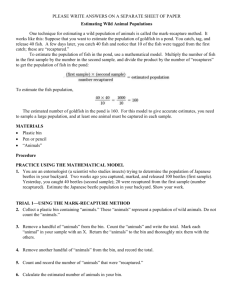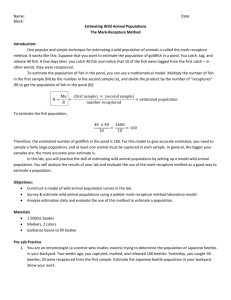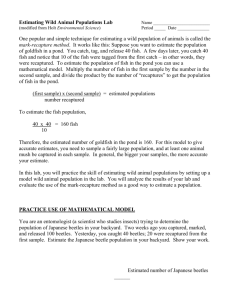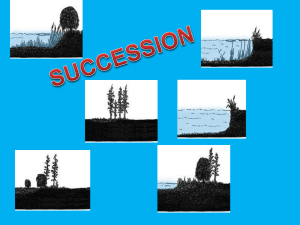Mark-Recapture Population Sampling Worksheet
advertisement
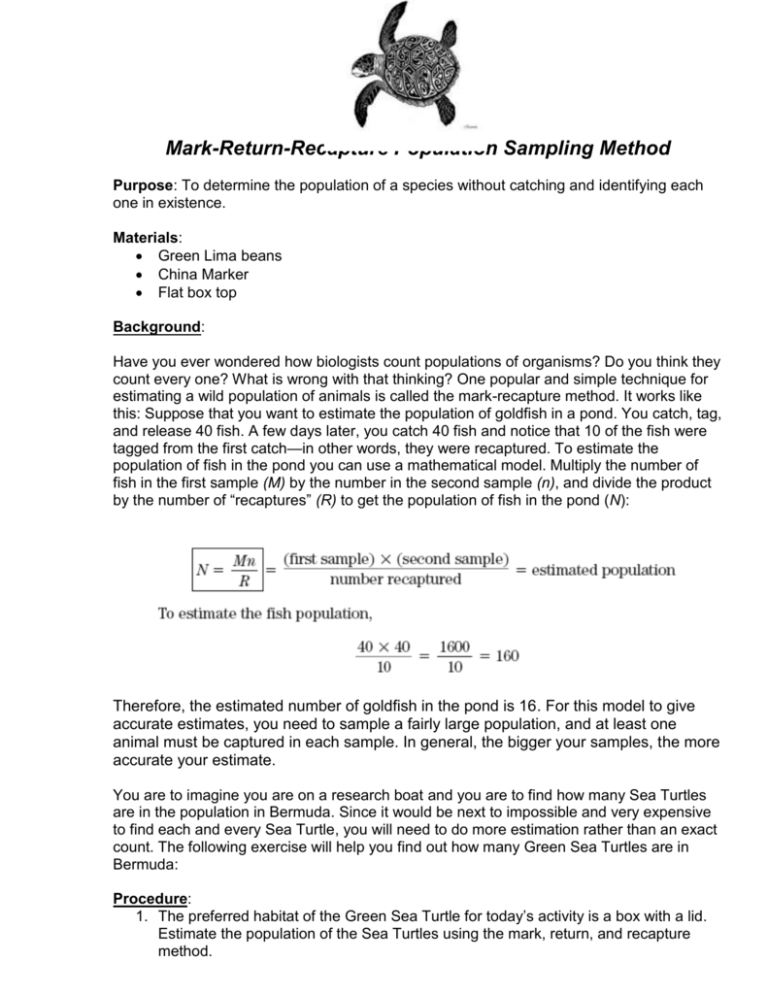
Mark-Return-Recapture Population Sampling Method Purpose: To determine the population of a species without catching and identifying each one in existence. Materials: Green Lima beans China Marker Flat box top Background: Have you ever wondered how biologists count populations of organisms? Do you think they count every one? What is wrong with that thinking? One popular and simple technique for estimating a wild population of animals is called the mark-recapture method. It works like this: Suppose that you want to estimate the population of goldfish in a pond. You catch, tag, and release 40 fish. A few days later, you catch 40 fish and notice that 10 of the fish were tagged from the first catch—in other words, they were recaptured. To estimate the population of fish in the pond you can use a mathematical model. Multiply the number of fish in the first sample (M) by the number in the second sample (n), and divide the product by the number of “recaptures” (R) to get the population of fish in the pond (N): Therefore, the estimated number of goldfish in the pond is 16. For this model to give accurate estimates, you need to sample a fairly large population, and at least one animal must be captured in each sample. In general, the bigger your samples, the more accurate your estimate. You are to imagine you are on a research boat and you are to find how many Sea Turtles are in the population in Bermuda. Since it would be next to impossible and very expensive to find each and every Sea Turtle, you will need to do more estimation rather than an exact count. The following exercise will help you find out how many Green Sea Turtles are in Bermuda: Procedure: 1. The preferred habitat of the Green Sea Turtle for today’s activity is a box with a lid. Estimate the population of the Sea Turtles using the mark, return, and recapture method. 2. Fill a jar halfway with lima beans. These beans represent a population of Green Sea Turtles. Do not count the beans. 3. As you sail into the ocean, you are going to capture and tag Green Sea Turtles. Do this by pulling out a hand full of beans from the box and marking them with and X with a china marker. Count the beans, and write the total number below: Total number of turtles first sampled:_____________________ 4. Your turtles are now tagged and released back into the ocean. 5. One year later, you go back to Bermuda and complete more research on Green Sea Turtles. What you will do, is grab another handful of beans. Mark on your data table below how many were captured, marked, and unmarked. 6. Replace the turtles back into the ocean. 7. Repeat steps 5 and 6 a total of 5 times and record your information on the data table. 8. To figure out the estimated population of Green Sea Turtles, do the following math using a calculator: (First Sample) X (Second Sample) Number Recaptured = Estimated Population Data Table Capture Number Number of Whales Captured Unmarked Estimated Population Marked 1________________________________________________________________________ 2________________________________________________________________________ 3________________________________________________________________________ 4________________________________________________________________________ 5________________________________________________________________________ Average Estimated Population Size: _______________________ Answer the following questions: 1. What was your lowest population estimate? __________________ 2. What was your highest population estimate? __________________ 3. Add all of the populations and find the average population. What was the average population? __________________ 4. Count all of the beans. How many were there in the box? ____________ 5. Was your estimate close to the actual number you counted? 6. Analyze the following situation. You captured, marked, and released 5 turtles from a pond, and caught 10 unmarked turtles the next day. Would you have enough information to estimate the population using the mark-recapture method? 7. Imagine that you are studying birds that are flying south for the winter. How might their migration affect the results of a mark- recapture study? Can you accurately estimate the migrating bird population using the mark-recapture method? Explain your answer. 8. Analyze the following situation. You are surveying two ponds, one large and one small, for goldfish. You catch, tag, and release 20 goldfish from each pond. The next day, you catch 20 goldfish from each pond and count 8 recaptures from the small pond and 2 from the large pond. a. Estimate the population of goldfish in the small pond. __________________________________________________________ b. Estimate the population of goldfish in the large pond. __________________________________________________________ c. Why would a large pond tend to have fewer recaptures than a small pond?


